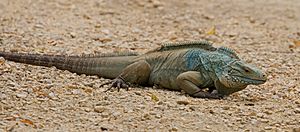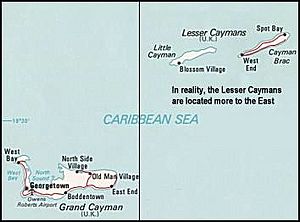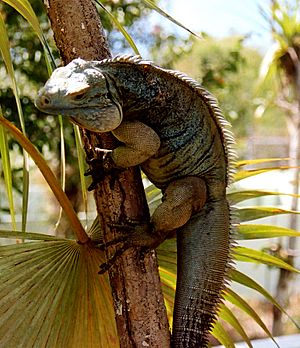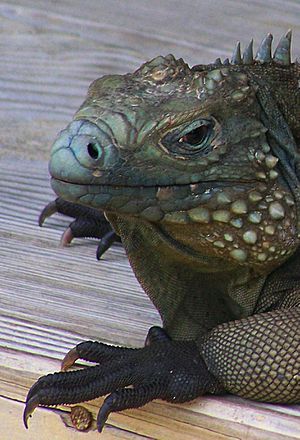Blue iguana facts for kids
Quick facts for kids Blue iguana |
|
|---|---|
 |
|
| A male in the Queen Elizabeth II Botanic Park, Grand Cayman | |
| Conservation status | |
| Scientific classification | |
| Genus: |
Cyclura
|
| Species: |
lewisi
|
| Synonyms | |
|
|
The blue iguana (Cyclura lewisi) is a special kind of lizard. It is also called the Grand Cayman blue iguana or Cayman Island rock iguana. This amazing animal lives only on the island of Grand Cayman. It is an endangered species, meaning it is at risk of disappearing forever.
Blue iguanas are known for living a very long time. Some have lived for up to 69 years! They like sunny, rocky places in dry forests or near the coast. Female iguanas dig holes in the sand to lay their eggs in summer.
These iguanas mostly eat plants, fruits, and flowers. Their skin is usually tan or gray, but it can look bluish, especially during mating season. Males often show more blue color. They are large lizards with a crest of short spines along their back.
Sadly, by 2003, fewer than 15 blue iguanas were left in the wild. Their numbers dropped because of predators like cats and dogs. Also, their homes were lost as farms changed. Since 2004, many captive-bred iguanas have been released to help save them. Several groups are working hard to protect these unique lizards.
Contents
What's in a Name?
The blue iguana's scientific name, lewisi, honors Charles Bernard Lewis. He was the scientist who first collected a sample of this species.
The blue iguana is closely related to the Cuban iguana and the Northern Bahamian rock iguana. It can even have babies with the Lesser Caymans iguana. These babies are fertile, meaning they can have their own babies.
In 1938, Charles Lewis found two blue iguanas. These were later sent to a museum in London. In 1940, Chapman Grant officially described the blue iguana as a new type of animal. He called it C. macleayi lewisi. Later, in 1975, it was reclassified as a subspecies of the Cuban iguana, named C. nubila lewisi.
In 2004, Frederic Burton, who runs the breeding program on Grand Cayman, said the blue iguana should be its own species. He noted that their skin color is a key difference. While all young iguanas hatch with the same color, lewisi becomes more blue as it grows up. Other types of iguanas can have more varied colors.
Other Names for the Blue Iguana
This animal was first called the Grand Cayman rock iguana. It was also known as the Grand Cayman blue rock iguana.
In 2004, Frederic Burton suggested new names for this iguana. He proposed Grand Cayman blue iguana or Cayman blue iguana. For everyday use, he suggested the simple name blue iguana.
It's good to know that the name "blue iguana" is sometimes used for bright blue types of the green iguana. But these are different species.
What Does a Blue Iguana Look Like?
The blue iguana is the biggest native land animal on Grand Cayman. It can grow up to 5 feet (1.5 meters) long, from nose to tail. It can weigh as much as 30 pounds (13.6 kg). This makes it one of the largest lizards in the Western Hemisphere.
Their toes are good for digging and climbing trees. Adult males are dark gray to turquoise blue. Females are more olive green to pale blue. Young iguanas are dark brown or green with faint stripes. These stripes fade as they get older.
Adult blue iguanas are usually dark gray, matching the rocks where they live. They change their color to blue when other iguanas are around. This helps them show their territory. The blue color is brighter in males. Their black feet stand out against their lighter bodies. Blue iguanas have golden eyes with red around them.
Males and females look a bit different. Males are larger and have bigger crests on their backs. They also have larger pores on their thighs. These pores release special scents called pheromones. Males can be one-third larger than females.
Where Do Blue Iguanas Live?
The blue iguana lives only on the island of Grand Cayman. As of 2012, they can be found across the island. They avoid busy city areas like Bodden Town and Seven Mile Beach.
Scientists think that a female Cuban iguana might have floated across the sea to Grand Cayman long ago. She might have had eggs inside her. This could be how the blue iguana first came to the island.
Blue Iguana Life
Their Home

Blue iguanas are found only on Grand Cayman. They used to live along the coast. But human homes and roads pushed them inland. Now, they live in dry shrubland. They also live near farms, roads, and gardens.
They like farm clearings and fruit farms. These places give them warm spots to sunbathe. They also find plants to eat and good soil for nesting. But this also brings them closer to people and wild animals. Female iguanas often travel to coastal areas to lay eggs.
Studies in 2004 showed how much space blue iguanas use. Females had territories of about 0.6 acres. Males had larger territories, about 1.4 acres. They often shared some areas. This means about four to five iguanas live in every hectare of land.
Blue iguanas live in rock holes and tree cavities. Adult iguanas mostly stay on the ground. But they have been seen climbing trees up to 15 feet (4.5 meters) high. Younger iguanas tend to climb trees more often.
What They Eat
Blue iguanas are mostly plant-eaters. They eat leaves, stems, flowers, nuts, and fruits. They eat from over 45 different types of plants. Sometimes, they might eat insects, crabs, slugs, or fungi. They have also been seen eating small rocks, soil, and bits of their own shedding skin.
Who Eats Them?
Young blue iguanas are sometimes eaten by a native snake called Alsophis cantherigerus. Adult blue iguanas have no natural predators.
How Long Do They Live?
We don't know exactly how long they live in the wild. But it is thought to be many decades. One blue iguana named "Godzilla" was caught in 1950. He lived in captivity until 2004. He was estimated to be 69 years old when he died. This might make him the longest-living lizard ever recorded! Another related iguana lived for 33 years in captivity.
Having Babies
Blue iguanas mate from May to June. Females lay 1 to 21 eggs in June or July. The number of eggs depends on the female's size and age. They dig nests in sunny spots. They might start several nests before finishing one.
These burrows can be from 16 inches (0.4 meters) to over 60 inches (1.5 meters) long. The end of the burrow is wider so the female can turn around. The eggs hatch after 65 to 90 days. The temperature in the nests stays around 32°C (90°F). Blue iguana eggs are some of the largest laid by any lizard.
Iguanas become very protective of their territory when they are about three months old. They can start having babies themselves after about four years, if they are in captivity.
Saving the Blue Iguana
Why They Are Endangered
The blue iguana is listed as endangered on the IUCN Red List. In 1988, only three iguanas were seen on the island. By 2003, there were only 5 to 15 left in the wild. In 2006, it was one of the most endangered lizards on Earth.
Thanks to conservation efforts, the number of blue iguanas has grown. In 2005, about 125 iguanas were released into protected areas. By April 2007, there were 299 blue iguanas living in the wild. Hundreds more were being raised in captivity. By late 2012, the wild population reached about 750 iguanas. Because of this success, their status was changed from "critically endangered" to "endangered."
Trading these iguanas internationally is controlled. This is because they are listed on Appendix I of the CITES agreement.
What Caused Their Decline?
The biggest threat to the blue iguana is the loss of their home. Land is cleared for farming, roads, and buildings. Farms that grew crops are now used for cattle. This takes away the iguanas' homes.
Rats eat young iguanas. Wild cats eat young and growing iguanas. Pet dogs kill adult iguanas. Cars and motorbikes also cause many deaths. Trapping and shooting used to be a problem, but this has mostly stopped.
The common green iguana has also been brought to Grand Cayman. It is an invasive species and there are many of them. While they don't directly harm blue iguanas, they can confuse people. People are told blue iguanas are rare, but they see many green iguanas that look similar.
By 2001, almost no young blue iguanas in the wild were surviving to have their own babies. This meant the wild population was almost gone, with only five iguanas left.
Efforts to Help Them
In 1990, the American Zoo and Aquarium Association made saving Cyclura iguanas their top goal. Their first project was a breeding program for the blue iguana on Grand Cayman.
One early challenge was that some captive iguanas were not pure blue iguanas. They were mixed with other types of iguanas. These mixed iguanas were prevented from having babies. This made sure that only pure blue iguanas were part of the breeding program. DNA tests showed that all captive blue iguanas in North America came from just one pair of iguanas.
To protect the blue iguana population, a group of 25 zoos in the USA started their own captive population in 2004. They keep at least 225 iguanas from different family lines.
In October 2006, young iguanas were released into the wild for the first time. Each released iguana wears colored beads on its neck for easy spotting. They also have a microchip and a photo of their head scales. These scale patterns are like fingerprints for humans.
The blue iguana is now raised in zoos and by private collectors. Most pure-bred iguanas are in official breeding programs. Breeding in the pet trade helps reduce the need to catch wild iguanas.
Blue Iguana Recovery Programme
The Blue Iguana Recovery Programme (BIRP) started small in 1990. It is now a team effort. Many groups work together, including the National Trust for the Cayman Islands and the Durrell Wildlife Conservation Trust.
BIRP's plan is to raise many genetically diverse baby iguanas. They "headstart" them, meaning they raise them for two years. This helps the young iguanas survive better in the wild. Then, these iguanas are released into protected areas. The goal is to quickly increase their numbers. This helps keep their genes diverse.
Iguanas have been released into two protected areas: the Salina Reserve and the Queen Elizabeth II Botanic Park. Protecting their habitat is still very important. The Salina Reserve has only 88 acres (35.6 hectares) of dry shrubland. This is not enough for the 1,000 blue iguanas they hope to restore. The plan in 2001 was to restore iguanas to more areas.
Once the wild populations are big enough for their protected areas, releasing head-started iguanas will slow down.
The captive iguana population will likely remain separated over time. To keep their genes healthy, iguanas should be moved between zoos.
The 2001 plan said that wild blue iguana breeding will need ongoing help. They hoped that different activities would raise money for this. In 2007, they started efforts to get local people involved and supportive.
In April 2019, one iguana laid 18 eggs. This was the first successful breeding since 2015.
See also
 In Spanish: Iguana azul para niños
In Spanish: Iguana azul para niños







